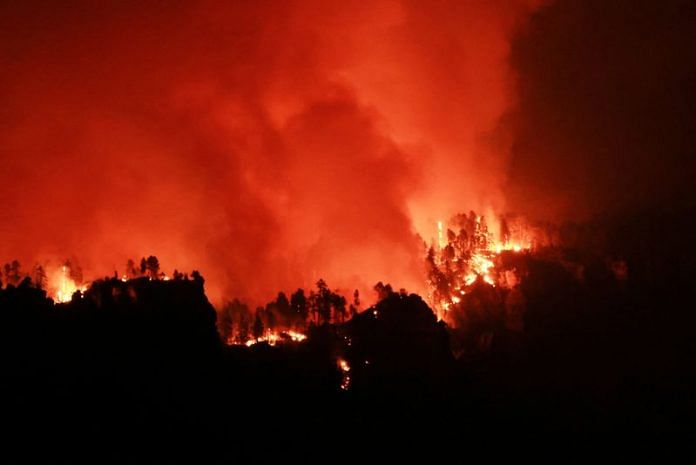By Andrew Hay
(Reuters) -The U.S. Forest Service faced criticism from current and former employees who say federal workforce reductions under the Trump administration have left fire teams understaffed, as the country grapples with decade-high U.S. wildfire numbers this year.
The agency, which oversees the nation’s largest wildland firefighting force, rejected those claims, saying it has sufficient resources.
However, more than a dozen active and retired U.S. Forest Service employees told Reuters that the agency is struggling to fill critical roles after approximately 5,000 employees – roughly 15% of its workforce – quit in the past five months.
Accounts from firefighters in Oregon and New Mexico, as well as a fire chief recruiting support staff in the Pacific Northwest, said the vacancies have led to personnel held back from supporting frontline firefighting because of administrative duties.
The crew leader on an Oregon blaze said her team went hungry for several days, ran short of medical supplies and had to scrounge for chainsaw fuel after support staff quit the agency during two rounds of “fork in the road” buyouts.
“I had guys who were going to bed hungry after working 16 hours,” said the crew leader on the Alder Springs Fire, who asked not to be named for fear of losing her job.
National and local USFS officials say, however, the force is ready for what is expected to be a worse than average fire year in California, the Pacific Northwest and the northern Rockies, according to National Interagency Fire Center forecasts.
“Our fire staff feels very confident in our staffing levels going into this fire season,” said USFS Public Affairs Officer Isabella Isaksen, who represents USFS operations in central Oregon.
Isaksen said food problems on the Alder Springs Fire were due to a new caterer and were quickly resolved. She said medical, chainsaw and other supplies were available on the 3,400-acre blaze that triggered evacuations in two counties.
‘THEY ARE READY’
The Trump administration pledged not to cut firefighting positions and other public safety jobs in firings, voluntary resignations and early retirements meant to raise efficiency at the USFS which manages 193 million acres of land (78 million hectares), roughly about the size of Texas.
USFS employees that Reuters interviewed for this story said the loss of thousands of foresters, biologists, trail builders and campground managers was having a knock-on effect on firefighters.
Not only are firefighters having to cover empty positions at ranger stations but they also have lost hundreds of peers who each year switched from regular jobs to take on firefighting support roles during the fire season, which typically runs from spring to fall, these people said.
USFS Chief Tom Schultz on Wednesday told agency managers to make all of these fire-qualified, so-called “red-carded” staff available for what he called an “extremely challenging” fire year, according to a memo seen by Reuters.
Year to date, wildland firefighters have been called to nearly 41,000 blazes, by far the highest number in federal data going back to at least 2015.
Last month Schultz told a U.S. Senate committee he was trying to temporarily hire back some 1,400 fire-qualified, “red-carded” support staff who took buyouts.
“I do believe they are ready,” Schultz said when asked about preparedness for the 2025 fire year.
FIREFIGHTERS MOW LAWNS
Agriculture Secretary Brooke Rollins, who oversees the USFS, said in June at a meeting of Western state governors in New Mexico that the agency was on target to hire 11,300 firefighters by mid July, outpacing hiring over the past three years.
As of June 29, 11,236 or 99% of that number had been hired, slightly below last year’s level, according to the most recent USDA data.
The USDA disputed claims that staff shortages are endangering communities, forests, and firefighters.
“We are providing the resources needed to ensure the Forest Service has the strongest and most prepared wildland firefighting force in the world,” a USDA spokesperson said.
New Mexico U.S. Senator Martin Heinrich has criticized the Trump administration’s firing and rehiring of 3,400 USFS probationary staff, three-quarters of whom were red-carded, as well as what he called its indiscriminate, agency-wide staff buyouts.
“Wildfire season is well underway, and thanks to DOGE and Donald Trump, the U.S. Forest Service is being gutted, leaving communities ill equipped to fight deadly wildfires,” Heinrich said in a emailed statement on July 11.
The Forest Service says it does not have enough wildland firefighters for the country’s “wildfire crisis” and relies on red-carded staff to “boost wildland firefighting capacity.”
Yet, not everyone close to the Forest Service sees problems.
Steve Ellis, chairman of the National Association of Forest Service Retirees, said his checks with fire staff in Oregon turned up no reports of firefighters going hungry or other support issues.
But Riva Duncan, a fire duty officer on a New Mexico blaze, said even firefighters were being used to plug gaps left by job losses, exacerbating longstanding shortages of personnel to operate fire engines.
“They’re answering phones at the front desk, or cleaning toilets at campgrounds or mowing the lawn at administrative sites,” said Duncan, a retired USFS fire chief who reenlists during fire season and helps run Grassroots Wildland Firefighters, a federal firefighter advocacy group.
The fire staff officer in the Pacific Northwest said support staff had been told by managers they had to meet the Trump administration’s increased timber sales and oil and gas production targets, with fewer employees, before helping firefighters.
“They can claim we get all the support we need, but in reality, it isn’t even close,” said the fire chief, who asked not to be named for fear of retaliation.
(Reporting By Andrew Hay; editing by Donna Bryson and Diane Craft)
Disclaimer: This report is auto generated from the Reuters news service. ThePrint holds no responsibility for its content.




